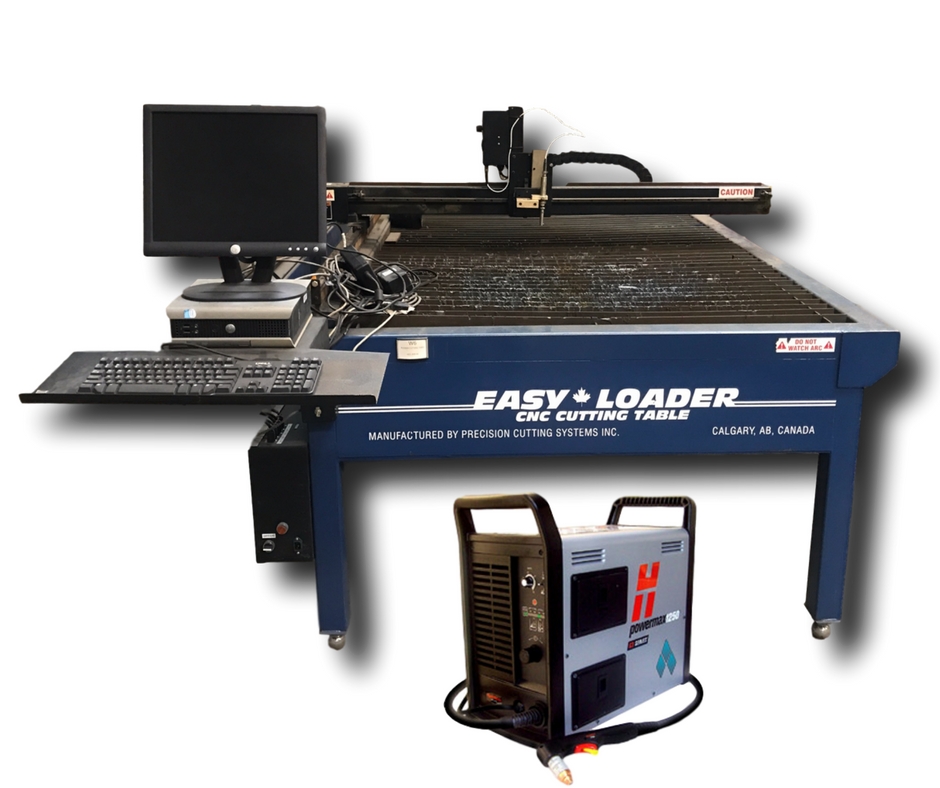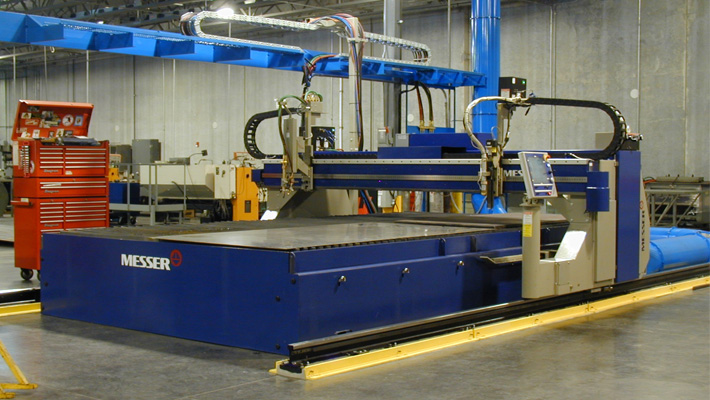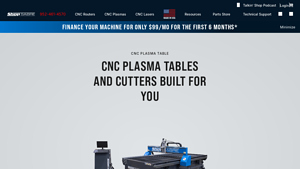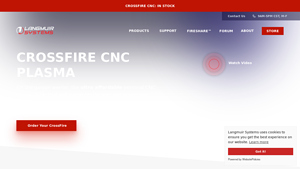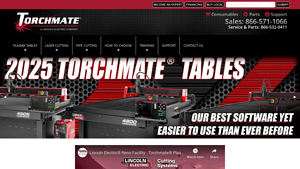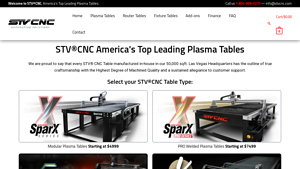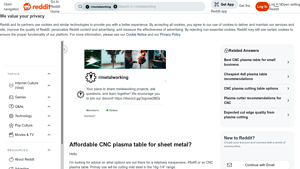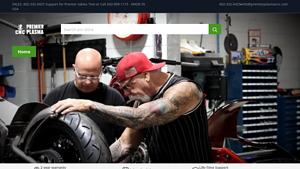Cnc Cutting Table Guide: Type, Cost, Top List…
Introduction: Navigating the Global Market for cnc cutting table
In an increasingly interconnected world, sourcing the right CNC cutting table can be a daunting task for B2B buyers, especially when faced with the complexities of varying specifications, applications, and supplier credibility. Whether you’re in the manufacturing sector in Nigeria, the metal fabrication industry in Germany, or the burgeoning market in South America, understanding the nuances of CNC cutting tables is crucial for optimizing production efficiency and ensuring quality output. This comprehensive guide serves as a roadmap for international buyers, delving into the diverse types of CNC cutting tables, their specific applications across industries, and essential factors for vetting suppliers.
Throughout this guide, we will explore critical elements such as operational capabilities, cost considerations, and the importance of selecting the right accessories and software to enhance productivity. By equipping yourself with knowledge on these aspects, you can make informed purchasing decisions that align with your business goals. This resource is tailored to meet the needs of buyers from Africa, South America, the Middle East, and Europe, providing insights that facilitate smart investments in cutting-edge technology. Ultimately, our aim is to empower you to navigate the global market confidently, ensuring that your CNC cutting table choice not only meets current demands but also positions your business for future growth.
Understanding cnc cutting table Types and Variations
| Type Name | Key Distinguishing Features | Primary B2B Applications | Brief Pros & Cons for Buyers |
|---|---|---|---|
| CNC Plasma Table | Utilizes plasma cutting technology; high-speed cutting; customizable sizes | Metal fabrication, automotive, sign making | Pros: Fast cutting speeds, precision; Cons: Requires high amperage for thick materials. |
| CNC Router Table | Equipped with rotary cutting tools; versatile for various materials | Woodworking, signage, prototyping | Pros: Handles a variety of materials; Cons: May not be suitable for thick metals. |
| CNC Laser Cutting Table | Uses laser technology for cutting; ideal for intricate designs | Aerospace, electronics, custom signage | Pros: High precision and clean edges; Cons: Limited material thickness compared to plasma. |
| CNC Waterjet Table | Employs high-pressure water to cut; no heat-affected zones | Stone cutting, metal fabrication | Pros: Can cut thick materials; Cons: Slower cutting speeds, higher operational costs. |
| CNC Oxy-Fuel Table | Combines oxygen and fuel gas for cutting; effective for thick materials | Heavy steel fabrication, construction | Pros: Economical for thick cuts; Cons: Slower than plasma cutting, requires more setup. |
What Are the Key Characteristics of CNC Plasma Tables?
CNC Plasma Tables are designed for high-speed cutting of conductive metals using plasma arc technology. They are distinguished by their ability to cut through materials with varying thicknesses, making them suitable for industries such as automotive and metal fabrication. Buyers should consider the table size, material thickness capacity, and the required amperage of compatible plasma cutters. The flexibility in customization options allows businesses to tailor their setup to specific production needs, enhancing efficiency and output.
How Do CNC Router Tables Differ from Other Types?
CNC Router Tables utilize rotary tools and are highly versatile, capable of cutting various materials such as wood, plastics, and soft metals. This makes them ideal for applications in woodworking, signage, and prototyping. When purchasing, businesses should evaluate the table’s size, spindle power, and the types of materials it can handle. While CNC routers offer great flexibility, they may not be the best choice for heavy-duty metal cutting, which is a significant consideration for companies focused on metal fabrication.
What Are the Advantages of CNC Laser Cutting Tables?
CNC Laser Cutting Tables are known for their precision and ability to create intricate designs with minimal kerf. They are particularly effective for applications in aerospace, electronics, and custom signage. Buyers should assess the power of the laser, the maximum material thickness it can handle, and the types of materials compatible with the system. While laser cutting provides clean edges and high accuracy, it is generally limited to thinner materials compared to plasma cutting, which may influence purchasing decisions.
Why Choose CNC Waterjet Tables for Your Business?
CNC Waterjet Tables use high-pressure water mixed with abrasives to cut through materials, making them ideal for applications in stone cutting and heavy metal fabrication. These tables can handle thicker materials without the heat-affected zones that other cutting methods may introduce. When considering a waterjet table, businesses should evaluate the cutting speed, operational costs, and maintenance requirements. While they offer versatility and precision for thick materials, the higher operational costs and slower cutting speeds compared to plasma tables can be a drawback.
What Should Buyers Know About CNC Oxy-Fuel Tables?
CNC Oxy-Fuel Tables combine oxygen and fuel gas to cut through heavy materials, making them suitable for heavy steel fabrication and construction applications. They are often more economical for cutting thick materials compared to plasma cutting. Buyers should consider the table’s cutting speed, setup time, and the types of materials typically processed. While oxy-fuel cutting is cost-effective for thick cuts, it generally has slower speeds and requires more setup time, which could impact production efficiency.
Key Industrial Applications of cnc cutting table
| Industry/Sector | Specific Application of CNC Cutting Table | Value/Benefit for the Business | Key Sourcing Considerations for this Application |
|---|---|---|---|
| Manufacturing | Metal Fabrication | Enhanced precision and reduced waste in production processes. | Consider table size, material thickness capabilities, and software compatibility. |
| Automotive | Auto Parts Production | Streamlined production of complex parts, leading to faster turnaround times. | Evaluate cutting speed, cutter compatibility, and customer support. |
| Signage and Advertising | Custom Sign Making | Ability to create intricate designs with high precision and efficiency. | Check for software integration, engraving options, and material handling features. |
| Construction | Structural Steel Cutting | Efficient cutting of steel beams and plates for construction projects. | Assess maximum cutting thickness, table durability, and ease of use. |
| Aerospace | Component Manufacturing | High precision cuts for safety-critical components, ensuring compliance with standards. | Prioritize quality certifications, material compatibility, and technical support. |
How is CNC Cutting Table Used in Manufacturing?
In the manufacturing sector, CNC cutting tables play a crucial role in metal fabrication processes. They enable businesses to achieve high precision cuts, minimizing material waste and maximizing production efficiency. This is particularly important for international buyers in regions like Africa and South America, where cost efficiency is vital. Buyers should consider factors such as the table’s size, material thickness capabilities, and compatibility with CAD/CAM software to ensure optimal performance for their specific manufacturing needs.
What Role Does CNC Cutting Table Play in Automotive Parts Production?
CNC cutting tables are extensively used in the automotive industry for the production of auto parts. They allow for the quick and precise cutting of various materials, including metals and composites, which is essential for producing complex components. This technology significantly reduces turnaround times, enabling manufacturers to respond swiftly to market demands. Buyers should look for machines that offer high cutting speeds and compatibility with advanced plasma cutters to enhance their production capabilities.
How is CNC Cutting Table Beneficial for Signage and Advertising?
In the signage and advertising industry, CNC cutting tables facilitate the creation of custom signs with intricate designs. The precision cutting capabilities allow businesses to produce high-quality signage that meets client specifications efficiently. For international buyers, especially in Europe and the Middle East, sourcing a CNC cutting table with robust software integration and engraving options is crucial to enhance design versatility and production speed.
What Advantages Does CNC Cutting Table Offer in Construction?
CNC cutting tables are essential in the construction industry for cutting structural steel. They streamline the process of preparing steel beams and plates, ensuring accurate cuts that fit project specifications. This efficiency can significantly reduce labor costs and project timelines. Buyers in the construction sector should prioritize tables that can handle heavy-duty materials and offer user-friendly operation to maximize productivity on job sites.
How Does CNC Cutting Table Impact Aerospace Component Manufacturing?
In aerospace manufacturing, CNC cutting tables are vital for producing components that require high precision due to safety regulations. These tables enable manufacturers to achieve the exact tolerances necessary for compliance with industry standards. International buyers should focus on sourcing tables that come with quality certifications and robust technical support to ensure reliability and safety in their production processes.
3 Common User Pain Points for ‘cnc cutting table’ & Their Solutions
Scenario 1: Limited Cutting Capacity for Diverse Materials
The Problem: Many B2B buyers encounter challenges when their CNC cutting tables cannot accommodate a range of material types and thicknesses. For instance, a metal fabrication shop might primarily work with mild steel but suddenly receive a contract for stainless steel or aluminum components. This limitation can lead to production delays, increased costs due to outsourcing, and potential loss of business opportunities.
The Solution: To address this issue, buyers should invest in CNC cutting tables that offer versatility in material handling. It’s crucial to assess the specific requirements of your projects, including the maximum thickness and types of materials you’ll be working with. Opt for tables like the Arc Max Series, designed to handle thicker plates and various materials efficiently. When selecting a plasma cutter, choose models that can be paired with your CNC table and are capable of cutting through multiple material types. Furthermore, consider acquiring additional accessories, such as a torch height control system, which enhances performance when cutting different materials. By aligning your equipment choices with your project needs, you can ensure seamless operation and minimize downtime.
Scenario 2: Complexity in Software Integration
The Problem: As CNC technology evolves, many B2B buyers struggle with software integration. New users may find the range of software options daunting—ranging from CAD for design to CAM for toolpathing and CNC for machine operation. This complexity can lead to inefficient workflows and increased training costs, particularly for companies in regions with limited access to technical support.
The Solution: To streamline software integration, businesses should prioritize CNC cutting tables that come with pre-installed, user-friendly software packages. For instance, systems like those offered by Arclight Dynamics include comprehensive software solutions like SheetCAM and QCAD, fully licensed and ready to use. Additionally, investing in training programs is essential; many manufacturers provide ongoing training and support. Consider leveraging online resources and tutorials to enhance your team’s skills and confidence in using the software. Establishing a clear workflow process and documentation for software usage can also minimize confusion and ensure smooth operations. By choosing a table with robust software support, companies can enhance productivity and reduce the learning curve.
Scenario 3: High Maintenance Costs and Downtime
The Problem: Maintenance of CNC cutting tables can lead to substantial operational costs, particularly for companies operating in regions with limited access to spare parts and technical expertise. Frequent machine breakdowns not only disrupt production schedules but can also result in significant financial losses due to idle time and repair expenses.
The Solution: To mitigate maintenance costs and reduce downtime, it is crucial to select CNC cutting tables designed for durability and ease of maintenance. Look for models that offer robust construction and come with a warranty that includes parts and service. For example, ShopSabre CNC tables are known for their reliability and come with lifetime technical support, ensuring that help is available when needed. Additionally, implementing a proactive maintenance schedule can help identify potential issues before they lead to breakdowns. This includes regular inspections, timely lubrication, and cleaning of components to prevent wear and tear. Stocking essential spare parts can also minimize downtime; consider working with suppliers who offer quick shipping options. By focusing on the longevity and reliability of your equipment, you can optimize operational efficiency and significantly reduce long-term costs.
Strategic Material Selection Guide for cnc cutting table
What Are the Key Materials for CNC Cutting Tables?
When selecting a CNC cutting table, the choice of material significantly influences performance, durability, and cost-effectiveness. Here, we analyze four common materials used in CNC cutting tables: steel, aluminum, composite materials, and stainless steel. Each material presents unique properties, advantages, and limitations that can affect the operational efficiency of the cutting table.
How Does Steel Perform as a Material for CNC Cutting Tables?
Steel is a prevalent choice for CNC cutting tables due to its strength and rigidity. It offers excellent temperature and pressure ratings, making it suitable for heavy-duty applications. Steel is also relatively cost-effective compared to other metals, which is a significant advantage for businesses looking to maximize ROI.
Pros: Steel’s durability and resistance to deformation under load make it ideal for high-precision cutting tasks. It can withstand rigorous use and is compatible with various cutting technologies.
Cons: However, steel is prone to rust and corrosion, especially in humid environments, which can require additional maintenance and protective coatings. Its weight can also pose challenges in terms of mobility and installation.
Impact on Application: Steel tables are ideal for heavy materials and applications requiring high stability and precision, such as manufacturing and fabrication.
Considerations for International Buyers: Compliance with standards such as ASTM A36 or DIN 17100 is crucial. Buyers in regions with high humidity, like parts of Africa and South America, should consider corrosion-resistant treatments.
What Are the Advantages of Aluminum for CNC Cutting Tables?
Aluminum is increasingly popular due to its lightweight nature and excellent corrosion resistance. It is particularly advantageous for applications requiring frequent relocation or adjustments.
Pros: The lightweight property of aluminum facilitates easier handling and installation, reducing labor costs. Its natural resistance to corrosion makes it suitable for environments prone to moisture.
Cons: On the downside, aluminum is softer than steel, which may lead to deformation under heavy loads. It is also generally more expensive than steel, which can impact budget considerations.
Impact on Application: Aluminum is well-suited for lighter materials and applications such as sign-making and prototyping, where precision is essential but heavy-duty strength is not as critical.
Considerations for International Buyers: Compliance with international standards such as ASTM B221 is important. Buyers should also be aware of the higher initial investment compared to steel.
How Do Composite Materials Fit into CNC Cutting Table Design?
Composite materials, such as phenolic resin or fiberglass, offer unique advantages for CNC cutting tables, especially in terms of weight and thermal stability.
Pros: Composites are lightweight and can provide excellent dimensional stability, making them ideal for high-precision applications. They are also resistant to chemicals and moisture, which enhances their longevity.
Cons: However, composites can be more expensive and may not offer the same load-bearing capacity as metals. They can also be more complex to manufacture and repair.
Impact on Application: Composites are suitable for specialized applications, including those involving sensitive materials that require a non-marring surface.
Considerations for International Buyers: Ensure compliance with relevant standards such as ASTM D638 for tensile properties. Buyers should also consider the availability of composite materials in their region, as sourcing can be more challenging.
What Role Does Stainless Steel Play in CNC Cutting Table Manufacturing?
Stainless steel is renowned for its corrosion resistance and aesthetic appeal, making it a preferred choice for environments where hygiene is critical, such as food processing or medical applications.
Pros: Its durability and resistance to rust make stainless steel an excellent long-term investment. It also maintains structural integrity under varying temperatures.
Cons: The primary disadvantage is the higher cost compared to carbon steel and aluminum. Additionally, stainless steel can be more challenging to machine, which may increase manufacturing complexity.
Impact on Application: Stainless steel tables are ideal for applications requiring cleanliness and resistance to corrosive substances, such as in food and pharmaceutical industries.
Considerations for International Buyers: Compliance with standards like ASTM A240 is essential. Buyers should also consider local pricing variations and availability of stainless steel grades.
Summary Table of Material Selection for CNC Cutting Tables
| Material | Typical Use Case for CNC Cutting Table | Key Advantage | Key Disadvantage/Limitation | Relative Cost (Low/Med/High) |
|---|---|---|---|---|
| Steel | Heavy-duty manufacturing | High strength and durability | Prone to rust and corrosion | Medium |
| Aluminum | Sign-making, prototyping | Lightweight and corrosion-resistant | Softer, more expensive than steel | High |
| Composite | Specialized applications | Excellent dimensional stability | More expensive, complex to manufacture | Medium to High |
| Stainless Steel | Food processing, medical applications | Corrosion-resistant and durable | Higher cost, machining complexity | High |
This guide provides a comprehensive overview of material selection considerations for CNC cutting tables, helping international B2B buyers make informed decisions based on their specific operational needs and regional conditions.
In-depth Look: Manufacturing Processes and Quality Assurance for cnc cutting table
What Are the Key Stages in the Manufacturing Process of CNC Cutting Tables?
The manufacturing process of CNC cutting tables involves several critical stages that ensure the final product meets the high precision and quality standards required by B2B buyers. Understanding these stages can help international buyers make informed decisions when selecting suppliers.
Material Preparation: What Materials Are Used and How Are They Processed?
The first step in manufacturing CNC cutting tables is material preparation. High-quality steel, aluminum, and sometimes composite materials are commonly utilized for their strength and durability. Suppliers typically source these materials from reputable vendors who comply with international standards to ensure consistency and reliability.
Once the materials are acquired, they undergo processes such as cutting, grinding, and machining to achieve the desired dimensions. Laser cutting or water jet cutting techniques are often employed to ensure precision. This initial stage is crucial as it lays the foundation for the performance of the CNC cutting table.
Forming: How Are CNC Cutting Tables Shaped and Assembled?
Following material preparation, the forming stage involves shaping the components of the CNC cutting table. Techniques such as bending, welding, and machining are employed to create the frame, gantry, and other structural elements. Advanced CNC machinery is often used to ensure high precision during this phase.
The assembly process is equally critical. Components are brought together in a controlled environment to minimize dust and contamination. Skilled technicians perform the assembly, ensuring that each part fits correctly and functions as intended. This stage may also involve the installation of electronic components, such as the control system, which is vital for the operational capabilities of the table.
Finishing: What Techniques Are Used to Enhance Durability and Aesthetics?
The finishing stage is where the CNC cutting table is prepared for final inspection and delivery. This can include powder coating, painting, or galvanizing to protect against corrosion and wear. The finishing process not only enhances the table’s aesthetics but also extends its lifespan, which is particularly important for B2B buyers operating in harsh environments.
Additionally, quality assurance checks are performed during this stage to ensure that all components meet the required specifications before moving on to the final quality control process.
How Do International Standards Influence Quality Assurance in CNC Cutting Tables?
Quality assurance (QA) is a critical aspect of the CNC cutting table manufacturing process. Buyers should be aware of the international and industry-specific standards that ensure product quality and safety.
What Are the Relevant International Standards for CNC Cutting Tables?
ISO 9001 is one of the most recognized international standards for quality management systems. Manufacturers aiming for ISO 9001 certification must demonstrate their ability to consistently provide products that meet customer and regulatory requirements. This standard is particularly valuable for international buyers as it signifies that the manufacturer adheres to globally accepted quality management practices.
In addition to ISO 9001, industry-specific standards such as CE marking in Europe and API standards for oil and gas applications are essential. These certifications ensure that the CNC cutting tables comply with safety, health, and environmental protection standards.
What Quality Control Checkpoints Should B2B Buyers Be Aware Of?
Quality control in the manufacturing process typically involves several checkpoints:
-
Incoming Quality Control (IQC): This stage assesses the quality of raw materials upon arrival at the manufacturing facility. It ensures that materials meet specified standards before they are used in production.
-
In-Process Quality Control (IPQC): During this stage, inspections and tests are conducted at various points in the manufacturing process. This helps identify defects early and reduces the risk of producing faulty products.
-
Final Quality Control (FQC): This is the last line of defense before products are shipped. It involves comprehensive testing and inspections to ensure that the CNC cutting tables meet all specifications and quality standards.
What Testing Methods Are Commonly Used in the Quality Control of CNC Cutting Tables?
Several testing methods are employed to verify the quality of CNC cutting tables:
-
Dimensional Inspection: This method checks critical dimensions to ensure they meet design specifications. Tools such as calipers and laser measuring systems are commonly used.
-
Functional Testing: This involves operating the CNC cutting table under various conditions to ensure it performs as expected. This may include testing the cutting speed, precision, and software integration.
-
Stress Testing: This test evaluates the structural integrity of the cutting table under load conditions. It helps identify potential weaknesses in the design or materials used.
How Can B2B Buyers Verify Supplier Quality Control Processes?
When sourcing CNC cutting tables, B2B buyers should take proactive steps to verify the supplier’s quality control processes:
-
Conducting Audits: Buyers can request audits of the manufacturing facility to assess the quality management system in place. This can provide insights into the supplier’s commitment to quality.
-
Reviewing Quality Reports: Suppliers should be willing to share quality assurance reports that detail their testing processes, outcomes, and any corrective actions taken.
-
Engaging Third-Party Inspectors: Utilizing independent third-party inspectors can provide an unbiased assessment of the manufacturing processes and quality control measures employed by the supplier.
What Are the Quality Control and Certification Nuances for International B2B Buyers?
International buyers, particularly from regions like Africa, South America, the Middle East, and Europe, should be aware of specific nuances in quality control and certification:
-
Regulatory Compliance: Different regions may have varying regulations regarding manufacturing standards. Understanding local compliance requirements is essential when importing CNC cutting tables.
-
Cultural Considerations: Building relationships with suppliers can be crucial in regions where personal connections play a significant role in business. This may also influence the level of transparency regarding quality control processes.
-
Logistics and Supply Chain Management: Ensuring that the supplier has robust logistics capabilities can help mitigate risks associated with quality during transportation. Buyers should inquire about packaging, handling, and shipping practices.
By understanding these manufacturing processes and quality assurance measures, B2B buyers can make informed decisions when sourcing CNC cutting tables, ensuring they invest in high-quality equipment that meets their operational needs.
Practical Sourcing Guide: A Step-by-Step Checklist for ‘cnc cutting table’
Introduction
This guide serves as a comprehensive checklist for B2B buyers looking to procure CNC cutting tables. By following these steps, you will ensure that your investment aligns with your operational needs and maximizes your production efficiency. Whether you’re in Africa, South America, the Middle East, or Europe, understanding these key aspects will empower you to make informed purchasing decisions.
Step 1: Define Your Technical Specifications
Before you begin sourcing CNC cutting tables, clearly outline your technical requirements. Consider factors such as table size, material thickness, and the types of materials you’ll be cutting. Understanding these specifications will help you narrow down your options and ensure the machine meets your operational needs.
- Table Size: Assess your workspace and choose a size that fits comfortably.
- Material Thickness: Identify the maximum and typical thickness of the materials you work with to select an appropriate machine.
Step 2: Evaluate Supplier Certifications
Verify that potential suppliers possess the necessary certifications and industry standards. This is crucial for ensuring product quality and compliance with safety regulations. Suppliers with recognized certifications are more likely to provide reliable and durable equipment.
- ISO Certification: Look for suppliers with ISO certifications, which indicate adherence to international quality management standards.
- Local Compliance: Ensure the supplier complies with local regulations and standards relevant to your region.
Step 3: Assess After-Sales Support and Warranty
A robust after-sales support system is essential for minimizing downtime and maintaining productivity. Before finalizing a purchase, inquire about the warranty period and the availability of technical support.
- Warranty Duration: Look for warranties that cover parts and labor for at least one year.
- Technical Support: Confirm the availability of ongoing technical support, including training and maintenance services.
Step 4: Examine Customization Options
Customization capabilities can significantly enhance the functionality of your CNC cutting table. Look for suppliers that offer a range of options to tailor the equipment to your specific needs.
- Accessories: Check for additional tools such as engravers, pipe cutters, or routers that can expand your machine’s capabilities.
- Software Integration: Ensure compatibility with design and operation software to streamline your workflow.
Step 5: Request Sample Cuts and Demonstrations
Before making a decision, request sample cuts or demonstrations from potential suppliers. This hands-on evaluation allows you to assess the machine’s precision and performance in real-world conditions.
- Material Variety: Ask for cuts in various materials to see how the machine handles different thicknesses and types.
- Performance Metrics: Evaluate the speed, quality, and accuracy of the cuts produced during the demonstration.
Step 6: Compare Pricing and Financing Options
Conduct a thorough comparison of pricing structures among different suppliers. Consider not just the initial cost, but also the long-term value and financing options available.
- Total Cost of Ownership: Factor in maintenance costs, potential upgrades, and consumables.
- Financing Plans: Explore financing solutions that may ease the upfront financial burden and support your cash flow management.
Step 7: Verify Customer Reviews and References
Finally, research customer reviews and request references from previous clients. This will provide insights into the supplier’s reliability and customer service.
- Case Studies: Look for case studies that demonstrate successful implementations in your industry.
- Direct References: Speak directly with past customers to gauge their satisfaction and any challenges faced post-purchase.
By following this checklist, you will be well-equipped to select a CNC cutting table that not only meets your technical specifications but also supports your business growth.
Comprehensive Cost and Pricing Analysis for cnc cutting table Sourcing
What Are the Key Cost Components in CNC Cutting Table Manufacturing?
Understanding the cost structure for CNC cutting tables is crucial for international B2B buyers. The primary cost components include materials, labor, manufacturing overhead, tooling, quality control (QC), logistics, and margin.
-
Materials: The choice of materials directly influences the cost. High-quality steel, aluminum, and composite materials are common, with prices fluctuating based on market demand and availability. For instance, plasma tables often require specific grades of steel for durability and performance.
-
Labor: Skilled labor is essential for both the assembly and maintenance of CNC cutting tables. Labor costs can vary significantly by region, with higher costs typically seen in developed markets like Germany compared to emerging markets in Africa or South America.
-
Manufacturing Overhead: This includes facility costs, utilities, and general administrative expenses. Efficient production processes can lower these overhead costs, allowing manufacturers to offer competitive pricing.
-
Tooling: The initial investment in tooling can be significant, especially for custom CNC cutting tables. This cost is often amortized over large production runs, which can make bulk orders more cost-effective.
-
Quality Control (QC): Ensuring the machines meet industry standards and certifications is critical, particularly for buyers in regulated markets. QC processes can add to the overall cost but are essential for maintaining product integrity.
-
Logistics: Shipping and handling costs can vary widely based on the origin of the product, the destination, and the shipping method. Incoterms play a crucial role in determining who bears these costs.
-
Margin: Finally, manufacturers will add a profit margin that varies depending on market conditions and competition. Understanding these margins can provide insight into the pricing flexibility available during negotiations.
How Do Price Influencers Affect CNC Cutting Table Costs?
Several factors can influence the pricing of CNC cutting tables, making it vital for buyers to consider these elements when sourcing.
-
Volume and Minimum Order Quantity (MOQ): Bulk purchases typically result in lower per-unit costs. Manufacturers often set MOQs to ensure production efficiency, so negotiating for larger orders can yield better pricing.
-
Specifications and Customization: Custom features, such as advanced cutting capabilities or specific dimensions, can significantly increase costs. Buyers should clearly define their requirements to avoid unexpected expenses.
-
Material Quality and Certifications: Higher quality materials and industry certifications can raise prices but often lead to better performance and longevity, which can justify the initial investment.
-
Supplier Factors: The reputation and reliability of the supplier can also affect pricing. Established suppliers may charge a premium for their expertise and customer service, which can be beneficial for buyers needing support.
-
Incoterms: Understanding shipping terms is crucial. Terms like FOB (Free On Board) or CIF (Cost, Insurance, and Freight) can impact the total cost of acquisition, including customs duties and insurance.
What Are the Best Negotiation Tips for B2B Buyers?
For international buyers, especially from diverse regions such as Africa, South America, the Middle East, and Europe, negotiating effectively can lead to substantial cost savings.
-
Research and Preparation: Familiarize yourself with market prices, competitor offerings, and supplier reputations. This knowledge provides leverage during negotiations.
-
Total Cost of Ownership (TCO): Consider the long-term costs associated with the CNC cutting table, including maintenance, operational costs, and potential downtime. A higher upfront cost may result in lower TCO if the machine is more reliable.
-
Flexibility in Specifications: Be open to alternative specifications that may lower costs without compromising essential functionality. Discussing various options with suppliers can uncover hidden savings.
-
Building Relationships: Establishing a rapport with suppliers can lead to better deals. Long-term partnerships often result in improved pricing and service.
-
Understanding Pricing Nuances: Be aware of regional pricing differences and how local economic conditions affect costs. This understanding can aid in negotiating better terms that are fair for both parties.
Disclaimer on Indicative Prices
While indicative prices for CNC cutting tables can provide a starting point for budget considerations, it’s essential to note that actual costs may vary significantly based on the factors discussed. Each buyer’s unique requirements and market conditions will ultimately dictate the final pricing.
Alternatives Analysis: Comparing cnc cutting table With Other Solutions
Exploring Alternatives to CNC Cutting Tables
In the landscape of industrial cutting solutions, CNC cutting tables are a popular choice for many businesses. However, there are alternative methods and technologies that can achieve similar cutting goals, each with distinct advantages and disadvantages. This analysis will compare CNC cutting tables with laser cutting machines and waterjet cutting systems, helping B2B buyers make informed decisions based on their specific operational needs.
| Comparison Aspect | CNC Cutting Table | Laser Cutting Machine | Waterjet Cutting System |
|---|---|---|---|
| Performance | High precision with varying thickness | Exceptional precision, fine details | Great for thick materials, less precision on fine details |
| Cost | Moderate initial investment | High initial investment | High initial investment |
| Ease of Implementation | Relatively easy setup | Requires skilled operators | Complex setup, extensive training needed |
| Maintenance | Moderate maintenance needs | Low maintenance | High maintenance due to wear parts |
| Best Use Case | Metal fabrication, signage, prototyping | Thin metals, intricate designs | Thick metals, composite materials |
In-Depth Analysis of Alternatives
Laser Cutting Machines
Laser cutting technology uses focused light to melt or vaporize material. This method excels in precision and is ideal for intricate designs, making it suitable for industries like jewelry manufacturing and electronics. However, laser cutting machines often come with a steep price tag, making them less accessible for smaller businesses. Additionally, they require skilled operators to maximize their capabilities, which can lead to higher operational costs. While maintenance is generally low, any necessary repairs can be costly due to the complexity of the equipment.
Waterjet Cutting Systems
Waterjet cutting employs high-pressure water jets to cut through materials. This technology is versatile, capable of handling a wide range of materials, including metals, glass, and composites. Waterjet systems are particularly effective for cutting thick materials, which makes them ideal for industries like aerospace and automotive. However, the initial investment can be significant, and the setup process is more complex compared to CNC cutting tables. Maintenance can also be demanding due to the wear on components from the high-pressure operation, potentially leading to increased downtime.
Making the Right Choice for Your Business
When selecting the best cutting solution, B2B buyers should consider their specific operational requirements, budget constraints, and the types of materials they frequently work with. CNC cutting tables offer a balanced mix of performance, cost-effectiveness, and ease of use, making them suitable for a broad range of applications. Conversely, if your business focuses on intricate designs or requires cutting through thick materials regularly, investing in laser or waterjet cutting technology may be justified. Ultimately, understanding the strengths and limitations of each alternative will enable you to make a strategic decision that aligns with your production goals and business needs.
Essential Technical Properties and Trade Terminology for cnc cutting table
What Are the Key Technical Properties of CNC Cutting Tables?
When investing in a CNC cutting table, several critical specifications must be considered to ensure that the equipment meets your operational needs. Here are some essential technical properties:
1. Table Size and Capacity
The size of the CNC cutting table directly impacts the types of projects you can undertake. Common sizes include 4×8, 5×10, and 6×12 feet. Larger tables can accommodate bigger sheets of material, which is essential for industries such as manufacturing and construction. Understanding your shop space and the maximum dimensions you can work with is crucial for optimizing material handling and workflow.
2. Material Thickness Capability
Each CNC cutting table is designed to handle specific material thicknesses, which can range from thin sheets to heavy plates. For instance, some tables can cut materials up to 3 inches thick, while others may only manage ½ inch. This specification is vital for B2B buyers, as it determines the range of projects the table can handle and influences the selection of compatible plasma cutters.
3. Cutting Tolerance
Tolerance refers to the precision of the cuts made by the CNC cutting table. A tighter tolerance means more accurate cuts, which is critical for high-quality production. In industries like automotive and aerospace, where precision is paramount, understanding the tolerance levels of different tables can significantly impact the final product quality.
4. Power Supply Requirements
CNC cutting tables require specific electrical configurations, typically ranging from 120V to 600V, depending on the model and its capabilities. Ensuring that your facility can support the required power supply is essential for operational efficiency and safety. This consideration can prevent costly modifications and downtime due to inadequate power.
5. Control System and Software Compatibility
The control system and accompanying software are pivotal for the operation of CNC cutting tables. Many modern machines come with intuitive software packages for design (CAD), nesting (CAM), and operation (CNC). Understanding the software capabilities and ensuring compatibility with your existing systems can enhance productivity and ease of use.
What Are Common Trade Terms Related to CNC Cutting Tables?
In addition to technical specifications, several industry-specific terms are essential for effective communication and decision-making in the B2B landscape.
1. OEM (Original Equipment Manufacturer)
An OEM refers to a company that produces parts and equipment that may be marketed by another manufacturer. Understanding the OEM relationship is crucial for buyers as it affects warranty, service, and replacement parts availability.
2. MOQ (Minimum Order Quantity)
MOQ denotes the smallest quantity of a product that a supplier is willing to sell. This is an important consideration for B2B buyers, as it can impact initial investment and inventory management. Knowing the MOQ helps in budgeting and planning for procurement.
3. RFQ (Request for Quotation)
An RFQ is a document used to solicit price quotes from suppliers for specific products or services. It is vital for buyers to issue RFQs to ensure they receive competitive pricing and terms, enabling informed purchasing decisions.
4. Incoterms (International Commercial Terms)
Incoterms are internationally recognized rules that define the responsibilities of buyers and sellers in global trade. Familiarity with these terms helps B2B buyers understand their obligations regarding shipping, insurance, and delivery, minimizing risks associated with international transactions.
5. Lead Time
Lead time refers to the amount of time it takes from placing an order to receiving it. Understanding lead times is crucial for B2B buyers to plan their production schedules and avoid delays in their projects.
6. TCO (Total Cost of Ownership)
TCO encompasses all costs associated with acquiring, operating, and maintaining a CNC cutting table over its lifespan. This term is essential for B2B buyers as it provides a comprehensive view of the financial commitment involved, beyond just the initial purchase price.
By understanding these technical properties and trade terms, B2B buyers can make informed decisions that align with their operational needs and strategic goals.
Navigating Market Dynamics and Sourcing Trends in the cnc cutting table Sector
What Are the Current Market Dynamics and Key Trends in the CNC Cutting Table Sector?
The CNC cutting table market is witnessing substantial growth driven by advancements in technology, increasing demand for automation, and the need for precision in manufacturing processes. International B2B buyers, particularly from regions such as Africa, South America, the Middle East, and Europe, are increasingly seeking high-quality, reliable CNC cutting tables that enhance their production capabilities. Key trends influencing this market include the integration of smart technology, such as IoT-enabled systems that allow for remote monitoring and predictive maintenance, thus reducing downtime and operational costs.
Moreover, as industries pivot towards customized solutions, manufacturers are offering modular CNC cutting tables that can be tailored to specific needs, accommodating various material types and thicknesses. This adaptability is critical for companies in sectors like metal fabrication, automotive, and aerospace, where precision and efficiency are paramount. The rise of e-commerce platforms also facilitates easier access to global suppliers, enabling buyers to compare products and prices more effectively.
In addition, sustainable practices are becoming a focal point for many international buyers. Companies are increasingly prioritizing suppliers that demonstrate environmental responsibility through energy-efficient operations and reduced waste. This trend is particularly relevant in regions where regulatory pressures regarding environmental impact are intensifying, making it essential for B2B buyers to stay ahead of compliance requirements.
How Is Sustainability and Ethical Sourcing Influencing the CNC Cutting Table Market?
Sustainability is reshaping the CNC cutting table sector, as both manufacturers and buyers recognize the importance of minimizing environmental impact. The production of CNC cutting tables often involves significant energy consumption and material waste, prompting a shift towards more sustainable practices. Many suppliers are now adopting energy-efficient technologies, utilizing renewable energy sources, and implementing waste reduction strategies to align with global sustainability goals.
Ethical sourcing is another critical aspect of this trend. B2B buyers are increasingly favoring suppliers who maintain transparent supply chains, ensuring that materials are sourced responsibly and ethically. This includes the use of recycled materials in the manufacturing of CNC cutting tables, which not only reduces the environmental footprint but also appeals to socially conscious consumers. Certifications such as ISO 14001 for environmental management and the use of green materials are becoming vital for suppliers aiming to attract international buyers.
Furthermore, as the demand for sustainable practices grows, companies that prioritize these values are likely to gain a competitive advantage in the marketplace. Buyers are encouraged to conduct thorough due diligence when selecting suppliers, ensuring that their partners not only meet quality standards but also adhere to ethical and sustainable practices.
What Is the Evolution of CNC Cutting Tables and Their Impact on B2B Buyers?
The CNC cutting table has evolved significantly since its inception, transitioning from rudimentary mechanical systems to advanced, computer-controlled machines that offer unparalleled precision and efficiency. In the early days, these machines were primarily used for simple cutting tasks, but advancements in technology have enabled them to perform complex operations, including engraving and multi-axis cutting.
This evolution has been driven by the increasing demand for customization and efficiency in manufacturing. Modern CNC cutting tables are equipped with sophisticated software that facilitates design, nesting, and toolpathing, allowing for a streamlined workflow that minimizes material waste and reduces production time. For B2B buyers, this means access to machines that not only enhance productivity but also support the growing trend of just-in-time manufacturing.
As international markets become more interconnected, the evolution of CNC cutting technology continues to influence sourcing decisions. Buyers now have access to a broader range of options, enabling them to select machines that best fit their operational needs while considering factors such as cost, performance, and sustainability. This continuous advancement in technology ensures that businesses can remain competitive in an increasingly globalized marketplace, making informed sourcing decisions essential for success.
Frequently Asked Questions (FAQs) for B2B Buyers of cnc cutting table
-
How do I choose the right CNC cutting table for my business needs?
Selecting the right CNC cutting table involves assessing your specific requirements such as material type, thickness, and production volume. Consider the table size that fits your workspace, ensuring ample room for material loading and unloading. Evaluate the cutting capabilities of different models, including the maximum thickness they can handle, which will dictate the plasma cutter you need. Additionally, think about future scalability; investing in a versatile machine with customizable features can accommodate potential business growth. -
What are the key factors to consider when sourcing a CNC cutting table from international suppliers?
When sourcing a CNC cutting table internationally, prioritize supplier reputation and experience in the industry. Verify their certifications and customer testimonials to ensure quality and reliability. Assess the availability of technical support and spare parts, as these factors are crucial for maintaining operations. Understand the import regulations and tariffs in your country, as well as the lead time for shipping, to avoid unexpected delays and costs. -
What customization options are typically available for CNC cutting tables?
Most CNC cutting table manufacturers offer a range of customization options to meet specific operational needs. Common options include varying table sizes, additional features like height adjustment, enhanced motion control systems, and specialized software packages. Some suppliers may allow for custom accessories such as pipe cutters or engraving tools. Discuss your requirements with potential suppliers to explore tailored solutions that can enhance your production capabilities. -
What is the minimum order quantity (MOQ) for CNC cutting tables when sourcing internationally?
The minimum order quantity for CNC cutting tables can vary significantly between suppliers and is influenced by the type of machine and customization options. Some manufacturers may have a MOQ of one unit for standard models, while others may require larger orders for customized solutions. Always clarify MOQ during negotiations to ensure alignment with your purchasing capabilities and to leverage potential discounts on larger orders. -
What payment terms should I expect when purchasing a CNC cutting table?
Payment terms for CNC cutting tables can differ by supplier and may include options such as upfront deposits, installment payments, or letters of credit for larger transactions. It’s crucial to discuss and negotiate terms that align with your cash flow and financial strategy. Ensure you understand any potential penalties for late payments and inquire about financing options, which may be available to help manage costs. -
How can I ensure quality assurance (QA) when buying CNC cutting tables?
To ensure quality assurance when purchasing a CNC cutting table, request detailed product specifications and compliance certifications from suppliers. Conduct factory audits or request video inspections of the manufacturing process if feasible. Additionally, verify warranty terms and after-sales support, as these are indicators of the manufacturer’s commitment to quality. Establish clear communication regarding performance expectations and testing procedures prior to shipping. -
What logistics considerations should I keep in mind when importing CNC cutting tables?
Importing CNC cutting tables involves several logistics considerations, including shipping methods, freight costs, and customs clearance procedures. Evaluate the best shipping options based on your delivery timeline and budget—air freight is faster but more expensive, while sea freight is cost-effective for larger items. Understand the customs regulations in your country, including duties and taxes, to avoid unexpected expenses. Collaborating with a reliable logistics partner can streamline the import process. -
What are the typical lead times for CNC cutting table delivery from international suppliers?
Lead times for CNC cutting table delivery can vary widely based on the supplier’s location, production capacity, and the complexity of the order. Standard models may have lead times ranging from a few weeks to a couple of months, while customized tables can take longer due to additional manufacturing processes. Always confirm estimated delivery times during the negotiation phase and factor in potential delays caused by shipping or customs clearance. Keeping open communication with the supplier can help manage expectations.
Important Disclaimer & Terms of Use
⚠️ Important Disclaimer
The information provided in this guide, including content regarding manufacturers, technical specifications, and market analysis, is for informational and educational purposes only. It does not constitute professional procurement advice, financial advice, or legal advice.
While we have made every effort to ensure the accuracy and timeliness of the information, we are not responsible for any errors, omissions, or outdated information. Market conditions, company details, and technical standards are subject to change.
B2B buyers must conduct their own independent and thorough due diligence before making any purchasing decisions. This includes contacting suppliers directly, verifying certifications, requesting samples, and seeking professional consultation. The risk of relying on any information in this guide is borne solely by the reader.
Top 8 Cnc Cutting Table Manufacturers & Suppliers List
1. ShopSabre – CNC Plasma Cutting Machines
Domain: shopsabre.com
Registered: 2002 (23 years)
Introduction: CNC Plasma Cutting Machines from ShopSabre offer precision and efficiency for metal fabrication. Key features include advanced motion control systems, user-friendly software, and customizable configurations. The machines are designed for various applications, including cutting steel, aluminum, and other metals. ShopSabre provides support and training to ensure optimal performance.
2. Langmuir Systems – CrossFire Personal CNC Plasma
Domain: langmuirsystems.com
Registered: 2017 (8 years)
Introduction: {‘product_name’: ‘CrossFire Personal CNC Plasma’, ‘price’: 1495, ‘shipping_estimate’: ‘2-3 Business Days’, ‘dimensions’: {‘cutting_envelope’: {‘X’: 25.3, ‘Y’: 23.3, ‘Z’: 3.0}, ‘expandable_dimensions’: {‘X’: 25.3, ‘Y’: 33.3, ‘Z’: 3.0}}, ‘weight’: 130, ‘features’: [‘Complete ready-to-assemble CNC Plasma Machine’, ‘FireControl CNC Control Software’, ‘Compatible with Autodesk Fusion 360 CAD/CAM Softwa…
3. Torchmate – CNC Plasma Tables
Domain: torchmate.com
Registered: 1998 (27 years)
Introduction: Torchmate CNC Plasma Tables include the following key products: 1. Torchmate 4000 Series: Available in sizes 4×4, 5×5, 4×8, and 5×10. Fully assembled and ready to run. 2. Torchmate 4400 and 4505: Educational packages with CAD design software and curriculum included. 3. Torchmate 5100: Industrial CNC plasma cutting table for all-day production, rugged components, and optional bevel head. 4. Torchma…
4. STV®CNC – CNC Plasma Cutting Tables
Domain: stvcnc.com
Registered: 2018 (7 years)
Introduction: STV®CNC offers a variety of CNC plasma cutting tables manufactured in-house in Las Vegas, NV, USA. Key product details include:
1. **Modular Plasma Tables**: Starting at $4999.
2. **PRO Welded Plasma Tables**: Starting at $7499.
3. **Servo Motor Plasma Tables**: Starting at $14499.
4. **Kustoms Plasma Tables**: Custom-built to suit specific needs.
5. **Hurricane Entry Level Plasma Table**: A…
5. CNC Plasma Table – Affordable 4ft x 4ft for Mild Steel Cutting
Domain: reddit.com
Registered: 2005 (20 years)
Introduction: Looking for a relatively inexpensive CNC plasma table for sheet metal, approximately 4ft x 4ft. Primary use will be cutting mild steel in the thickness range of 18g to 1/4″. Questions raised about cut edge quality and ability to cut smaller holes (1/4″ diameter). Intended for prototyping work rather than full production, with cost being a significant factor.
6. Piranha – CNC Plasma Tables
Domain: piranhafab.com
Registered: 1999 (26 years)
Introduction: CNC Plasma Tables by Piranha are tough, capable, and affordable, starting at $8,999. The A Series plasma table is designed for hobby to light industrial cutting needs, with complete systems starting at $8,999 (or $5,999 for table-only). The B Series offers high-end features for lighter duty cutting cycles, starting at $15,199 for 4×8 and $16,799 for 5×10 tables. The C Series provides reliable qual…
7. Premier Plasma CNC – Plasma Cutting Machines
Domain: premierplasmacnc.com
Registered: 2017 (8 years)
Introduction: Buy Plasma CNC Cutting Machine In the USA – Premier Plasma CNC. Products include CNC Plasma Tables, Turnkey Systems, Router Tables and Kits, Software, Premier Accessories, and Pipe Cutters. All products are made in the USA.
8. Boss Tables – CNC Plasma Tables
Domain: bosstables.com
Registered: 2018 (7 years)
Introduction: This company, Boss Tables – CNC Plasma Tables, is a notable entity in the market. For specific product details, it is recommended to visit their website directly.
Strategic Sourcing Conclusion and Outlook for cnc cutting table
In the competitive landscape of CNC cutting tables, strategic sourcing emerges as a critical factor for success. Buyers must prioritize quality, customization options, and the ability to scale operations according to their specific needs. Understanding the nuances of table size, material compatibility, and cutting technology can significantly enhance operational efficiency and product output. Furthermore, leveraging local suppliers or manufacturers can reduce lead times and improve service responsiveness, especially for international buyers in regions like Africa, South America, the Middle East, and Europe.
As you contemplate your next investment in CNC cutting technology, consider the long-term benefits of a well-sourced cutting table that aligns with your operational goals. Embrace innovation by exploring advanced features, such as integrated software solutions and customizable accessories, which can elevate your production capabilities.
Now is the time to act. Engage with trusted suppliers, request personalized consultations, and explore financing options to secure the best machinery for your business. By making informed decisions today, you will position your operations for growth and success in an evolving market.
